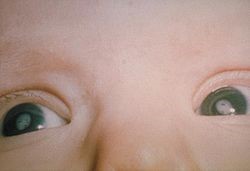It is the cause of 15-20% of blindness in children in industrialized countries. When bilateral, they are usuallyassociated with a metabolic disease, hereditary syndrome or maternal infection during pregnancy (see table).
There are partial cataracts classified according to the changes observed in the lens: nuclear, zonular or lamellar, coral-shaped, posterior precapsular, anterior polar, subcapsular, stellate or modification of the Y suture the diagnosis of which is often difficult with variable visual impact.Total cataracts cause 'deprivation' nystagmus when bilateral or strabismus with amblyopia, when unilateral.

|
Polymalformative syndromes and craniofacial malformations Smith-Lemli-Opitz Hallerman-Streiff-Franšois Zellweger Goldenhar Rubinstein-Taybi COFS Marshall SHORT |
|
Craniosynostoses Oxycephaly, Apert, Crouzoná Cleidocranial dysostosis |
|
Musculoskeletal diseases Myotonic dystrophy Punctate epiphyseal disease Albright syndrome Stickler syndrome Roberts syndrome |
|
Cutaneodental diseases Cockayne Progeria Incontinentia pigmenti von Recklighausen type II Riley-Day Ectodermal anhidrotic dysplasia X-linked ichthyoid dermatitis Schafer with palmoplantar dyskeratosis Nance-Horan with dental anomalies |
|
Neurologic diseases Sj÷gren Marinesco-Sj÷gren Meckel Sotos |
|
Metabolic diseases Galactosemia Hurler Hunter Mannosidosis Fabry disease Di George X-linked hereditary hypoparathyroidism Refsum Deficiency in ─1-pyrroline-5-carboxylase synthase Deficiency in glucose-6-phosphate dehydrogenase |
|
Renal diseases Lowe syndrome Alport syndrome |
|
Mitochondrial diseases Sengers Kerns-Sayres |
|
Infectious diseases Congenital rubella Congenital measles CMV Varicella Herpes |
|
Chromosomal involvements Turner Noonan Trisomy 13, 18, 21 Partial or complete monosomy 21 Deletioná: 2q, 3q, 4p (Wolff-Hirschhorn), 5 p (cri du chat syndrome), 13q, 18p, 18q Duplicationá: 2p, 3q, 5p, 9p, 10q, 15q Triploidy |
|
Ocular anomalies Aniridia (associated or not to WAGR syndrome) Peters anomaly Persistent pupillary membranes Primary persistent vitreous body hyperplasia Microphthalmia Retinal dysplasia |
|
Acquired cataracts Posttraumatic Corticotherapy Radiotherapy |
Causes of cataract in children
Treatment of infant cataracts is controversial. Some prefer phacoemulsification (ultrasonic destruction of the lens) followed by the use of contact lenses, others the implantation of an intraocular lens. If an obstructing cataract is present from birth, early treatment must be applied to avoid amblyopia: before 5 weeks in case of unilateral involvement and before 7 weeks in case of bilateral involvement..
Anesthetic implications:
according to the associated anomalies; open eye surgery: avoid any increased intraocular pressure (glaucoma is sometimes associated) and ensure a perfect stillness of the eyeball. As the iridic dilator muscle gets mature only 2-3 months after the birth, it can be difficult to obtain good mydriasis to perform surgery: different mydriatic eyedrops, para - and sympatholytic, have thus to be associated while avoiding overdosage by systemic absorption (nasolacrimal channel). Intraoperative analgesia is usually provided by administration of opiates. It can be provided with equivalent efficiency by application on the cornea of 2% lidocaine gel just preoperatively.
Referencesá:
- Lin AA, Buckley EG.
Update on pediatric cataract surgery and intraocular lens implantation.
Curr Opin Ophthalmol 2010; 21:55-9.
- Sinha R, Subramaniam R, Chhabra A, Pandey R, Nandi B, Jyoti B.
Comparison of topical lignocaine gel and fentanyl for perioperative analgesia in children undergoing cataract surgery.
Pediatr Anesth 2009; 19:371-5.
- Roche O, Beby F, Orssaud C, Dupont Monod S, Dufier JL.
Cataracte congÚnitale.
J Fr Ophtalmol 2006; 29:443-55.
Updated: May 2017